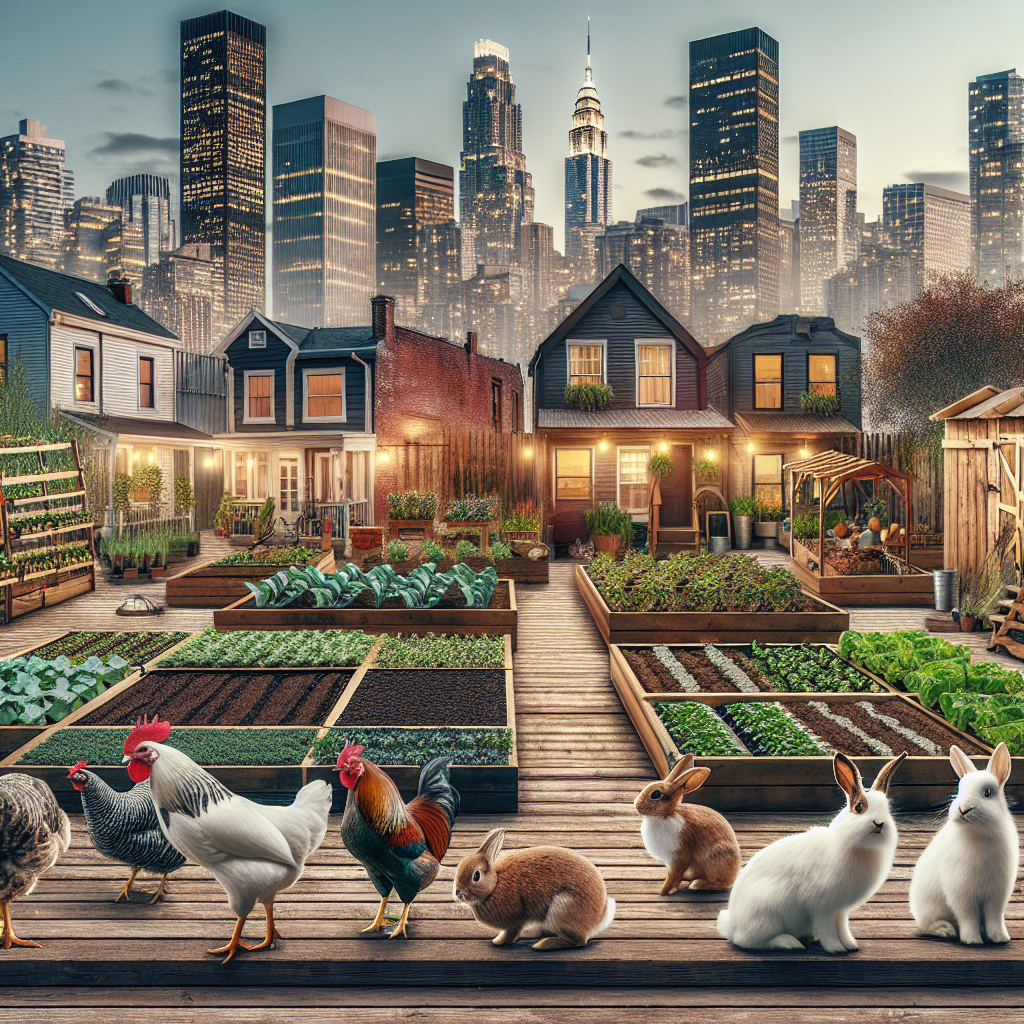
Are you one of those urban dwellers who dreams of having your own livestock, like goats or rabbits, but feel restricted by your small yard? Guess what – managing urban livestock in small yards is totally possible! In this article, we’ll explore some valuable tips and tricks that will enable you to successfully raise and care for livestock even within the confines of your urban space. So, get ready to learn how to turn your petite patch of land into a thriving haven for your furry friends!

Choosing the Right Livestock
Choosing the right livestock for your small yard is crucial to ensure their well-being and your success as a livestock owner. Before making any decisions, assess the available space in your yard. Analyze the size and layout of your yard to determine the types and number of animals that can comfortably fit.
Another important consideration when choosing livestock is to familiarize yourself with local regulations and restrictions. Verify if there are any zoning laws or neighborhood association rules that may affect your ability to keep certain types of livestock. It’s always better to be aware of these regulations from the outset to avoid any legal issues or disagreements with your neighbors.
When selecting suitable livestock breeds, take into account the climate, space, and purpose of your livestock. Some breeds may be more adaptable to urban environments, have smaller space requirements, or be more suitable for specific purposes such as milk production or meat. Research different breeds and consult with local farmers or agricultural experts to find the best fit for your yard and goals.
Lastly, evaluate the purpose and requirements of livestock you’re considering. Determine whether you’re keeping livestock for milk, meat, eggs, or as pets. Understanding the purpose will help you make informed decisions about the specific needs of each animal and ensure your livestock thrives in their new home.
Creating Adequate Shelter
Once you’ve chosen your livestock, creating adequate shelter is essential to provide them with a safe and comfortable environment. Given the limited space in small yards, it’s important to design a shelter that is compact and efficient. Consider the size of your livestock and plan a shelter that meets their needs without occupying excessive space.
When designing the shelter, optimize space utilization by incorporating features such as vertical storage or utilizing multipurpose areas. By smartly organizing the shelter, you can efficiently use the available space and ensure that your livestock has enough room to move around.
Proper ventilation and lighting are crucial for the well-being of your livestock. Make sure to design the shelter in a way that allows for adequate air circulation and natural light to enter. This will help prevent the buildup of harmful gases and keep your animals healthy and comfortable.
Implementing safety measures is also vital to protect your livestock from potential hazards. Install secure fencing and enclosures to prevent escape or intrusion. Additionally, consider fire safety measures such as fire extinguishers and smoke detectors to minimize the risk of accidents.
Providing Appropriate Nutrition
As a responsible livestock owner, providing appropriate nutrition plays a key role in your animals’ health and productivity. Different livestock have varying dietary needs, so it’s essential to understand the specific requirements of your chosen animals.
In small yards, adapting feeding strategies is necessary to accommodate limited spaces. Explore options such as vertical feeding systems or compact feeders to optimize space utilization. This will help ensure that your livestock receives sufficient food while minimizing waste and mess.
Utilize local forage and feed options whenever possible. Research the availability of locally sourced feed and explore options for growing your own feed crops. This not only reduces costs but also promotes sustainability by decreasing the reliance on external resources.
Managing food waste and composting are important considerations when it comes to livestock nutrition. Find ways to minimize food waste and repurpose it, either by feeding it to livestock or composting it for use as fertilizer. Effective waste management not only benefits the environment but also helps you save money on feed costs.
Managing Waste and Odor
Proper waste management is crucial to maintain a clean and odor-free environment in your small yard. Implement effective waste management systems to ensure that waste is handled in an environmentally friendly and hygienic manner.
Consider using composting techniques to manage organic waste effectively. Composting not only helps reduce waste but also produces nutrient-rich compost that can be used to fertilize your plants. Educate yourself on proper composting methods and implement them in your yard to minimize waste and contribute to a healthier environment.
Reducing odors is an important aspect of managing livestock in urban settings. Regular maintenance and cleaning of the shelter, along with proper waste management, can help minimize unpleasant odors. Explore natural odor control options such as using absorbent materials or odor-neutralizing agents to create a more pleasant environment for both you and your neighbors.
Addressing concerns about manure disposal is crucial to maintaining good relationships with your neighbors and the community. Look into local regulations and guidelines for manure disposal and find appropriate and responsible ways to handle it. Consider options such as using manure as fertilizer or donating it to local farmers or gardeners who can benefit from it.

Ensuring Health and Hygiene
Maintaining the health and hygiene of your livestock is essential for their overall well-being and productivity. Implement regular health checks and vaccinations to prevent and detect any potential illnesses or diseases. Consult with a veterinarian to develop a suitable health care plan for your livestock.
Proper hygiene and sanitation are equally important in small yards. Regularly clean and disinfect the shelter, feeding areas, and water sources to prevent the buildup and spread of harmful bacteria or parasites. Provide clean and fresh water at all times to ensure your livestock remains hydrated and healthy.
Preventing and controlling parasites and diseases is a critical aspect of livestock management. Implement effective parasite control measures, such as regular deworming, proper grooming, and monitoring for any signs of infestation. Additionally, practice biosecurity measures to minimize the risk of disease transmission, such as limiting contact with outside animals and practicing good hygiene practices.
In case of any health issues or emergencies, it’s crucial to seek professional veterinary care. Establish a relationship with a reliable veterinarian who specializes in livestock, and consult them whenever you have concerns or require expert advice.
Maximizing Yard Space
Maximizing yard space is essential when managing livestock in small yards. With careful planning and design, you can make the most of the available area and provide adequate space for your animals to graze, exercise, and move freely.
Utilize vertical space for livestock by implementing features such as vertical feeding systems or elevated platforms for resting. This allows you to provide ample vertical grazing or resting area without occupying valuable ground space.
Creating multipurpose areas is another effective way to maximize yard space. Consider incorporating features such as movable fencing or portable shelters that can be adjusted to create different zones within your yard. This versatility allows you to utilize the space efficiently for various purposes.
Implementing efficient storage solutions is crucial in small yards where space is limited. Find ways to store feed, tools, and equipment in an organized and accessible manner. Utilize compact storage systems or creative solutions such as hanging racks or storage bins to minimize clutter and make the most of available space.
Optimizing space for grazing or exercise is essential for the well-being of your livestock. Provide sufficient space for them to move around and engage in natural behaviors like grazing or playing. Design your yard in a way that allows for rotational grazing or provide designated areas for exercise to ensure your animals remain healthy and active.

Minimizing Noise and Nuisance
Minimizing noise and nuisance is crucial when keeping livestock in urban areas. Consider the noise levels of different livestock species and choose breeds known for their low noise levels. This will help minimize disturbances for both yourself and your neighbors.
Implementing soundproofing measures within the shelter can further reduce noise transmission. Incorporate materials or design elements that help absorb sound, such as acoustic panels or insulation. Additionally, address any structural issues that may amplify noise, such as creaky doors or loose roofing.
It’s important to consider your neighbors’ concerns when managing livestock in small yards. Engage in open and proactive communication, and be willing to address any concerns or complaints they may have. By maintaining good relationships with your neighbors, you can create a harmonious living environment for everyone.
Maintaining a good relationship with the community is equally important. Share your knowledge and experiences with others who may be interested in urban livestock keeping. Participate in local livestock communities or organizations, attend workshops, and engage in discussions to learn from others and promote a positive image of urban livestock keeping.
Ensuring Safety and Security
Ensuring the safety and security of your livestock is vital to protect them from harm. Construct secure fences and enclosures to prevent escape or intrusion. Regularly inspect the fencing for any signs of damage and promptly repair or replace any compromised areas.
Preventing escape or intrusion also involves being mindful of potential weak points in your yard. Consider locking gates or using additional measures such as padlocks or motion sensor lights to deter unauthorized access. Regularly check for any potential hazards that may allow predators or other animals to enter your yard.
Protecting livestock from predators is essential when keeping them in urban areas. Implement measures such as installing secure fencing with predator-proof barriers, netting, or electric fencing. Additionally, consider employing guardian animals or using predator deterrents to minimize the risk of wildlife or domestic animals posing a threat to your livestock.
Implementing fire safety measures is equally important, especially in small yards where space is limited. Install smoke detectors and fire extinguishers within or near the shelter. Regularly inspect electrical systems, heating sources, and any potential fire hazards to minimize the risk of fire.

Educating Yourself and Others
Keeping livestock in urban areas requires continuous learning and staying updated with the latest practices and regulations. Attend workshops and training sessions offered by local agricultural organizations or government agencies to expand your knowledge. These learning opportunities will provide valuable insights and techniques to improve your livestock management skills.
Joining local livestock communities or organizations is another effective way to learn from others and share experiences. Engage in discussions, ask questions, and participate in community events or farm tours to gain knowledge and build connections with fellow livestock owners.
Sharing your knowledge and experiences with others is not only beneficial for their understanding but also helps to promote responsible and sustainable urban livestock management. Host workshops or informational sessions for your neighbors or interested community members to educate them about the benefits and challenges of managing livestock in small yards.
Keeping up-to-date with the latest practices and regulations is essential to ensure that you’re complying with any changes in laws or guidelines. Regularly check for updates from local agricultural authorities or get involved in discussions and forums to stay informed about any developments in urban livestock management.
Considering Ethical and Welfare Standards
Maintaining ethical and welfare standards is the cornerstone of responsible livestock management. Provide appropriate living conditions by ensuring that your animals have shelter, access to clean water, and shade. Consider their natural behaviors and provide them with an environment that allows them to express these behaviors.
Avoid overcrowding your livestock, as this can lead to stress and increased disease risk. Ensure that each animal has sufficient space to move around comfortably and interact with others. Plan your livestock numbers and their housing arrangements accordingly to prevent overcrowding.
Respecting animals’ natural behaviors is essential for their physical and mental well-being. Design the shelter and yard in a way that allows your livestock to engage in natural behaviors such as grazing, perching, or exploring. Providing opportunities for mental and physical stimulation helps to prevent boredom and improves the overall welfare of your animals.
As a responsible livestock owner, it’s important to continuously assess and monitor your animals’ welfare. Regularly observe their behavior, physical condition, and productivity to identify any signs of distress or health issues. Make adjustments to their environment or management practices as needed to ensure their welfare remains a top priority.
Managing urban livestock in small yards requires careful consideration and planning. By following these tips and tricks, you can create a harmonious environment for both your livestock and your neighbors while enjoying the benefits of raising animals in an urban setting.






